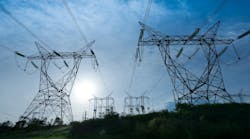The Federal Energy Regulatory Commission has finalized rules to bolster investment in the nation’s aging transmission infrastructure, and to promote electric power reliability and lower costs for consumers, by reducing transmission congestion. The final rule identifies specific incentives the Commission would allow based on a case-by-case analysis of individual transmission proposals.
“Today’s final rule provides increased regulatory certainty and procedural flexibility to encourage much-needed investment in all areas of the country,” Commission Chairman Joseph T. Kelliher said. “There has been a sustained period of underinvestment in the transmission system. Notwithstanding, use of the nation’s grid has more than doubled in recent years. It is clear that we need to strengthen the system to meet consumer demand and today’s rule takes a significant turn in that direction. Underinvestment in the grid is a national problem. Today, we offer a solution.”
The Energy Policy Act of 2005 directed the Commission to develop incentive-based rate treatments for transmission of electric energy in interstate commerce, adding a new section 219 to the Federal Power Act. The final rule implements this new statutory directive.
For the most part, the final rule adopts the proposals put forth in the Commission’s November 2005 proposed rulemaking. Key provisions of the rule include:
- Incentive rates of return on equity for new investment by public utilities (both traditional utilities and stand-alone transmission companies, or transcos);
- Full recovery of prudently incurred construction work in progress;
- Full recovery of prudently incurred pre-operations costs;
- Full recovery of prudently incurred costs of abandoned facilities;
- Use of hypothetical capital structures;
- Accumulated deferred income taxes for transcos;
- Adjustments to book value for transco sales/purchases;
- Accelerated depreciation;
- Deferred cost recovery for utilities with retail rate freezes; and
- A higher rate of return on equity for utilities that join and/or continue to be members of transmission organizations, such as (but not limited to) regional transmission organizations and independent system operators.
All rates approved under the rules would be subject to Federal Power Act rate filing standards, the Commission noted. The rule does not grant utilities all of the listed incentives, but rather allows utilities on a case-by-case basis to select and justify the package of incentives needed to support new investment. Additionally, the rule provides expedited procedures for the approval of incentives to provide utilities greater regulatory certainty and facilitate the financing of projects.
The Commission is adopting an annual reporting requirement, FERC Form 730, which will be required from utilities that have received incentive rate treatment for specific transmission projects. The annual reporting requirement would include projections and related information that detail the level of transmission investment.
In separate actions today, the Commission granted transmission investment incentive rate requests to two companies. Approved were incentive rate requests filed by American Electric Power (AEP) Service Corp. and by Allegheny Energy Inc. and its affiliated utility companies. Both requests were for transmission projects proposed for the Mid-Atlantic regional power grid operated by PJM Interconnection.
In the AEP proceeding, the Commission conditionally approved proposed incentive rates for a new 765-kV, 550-mile transmission line that would extend from West Virginia to New Jersey. The approved incentives include: (1) an ROE set at the high end of the zone of reasonableness; (2) the option to timely recover the cost of capital associated with construction work in progress (CWIP); and (3) the ability to expense and recover the costs AEP incurs during the pre-construction and pre-operating period.
In the Allegheny proceeding, the Commission granted the four incentives requested by the company and its subsidiaries, Monongahela Power Co., Potomac Edison Co. and West Penn Power Co. Allegheny proposes to construct a 500-kV transmission line within the PJM region. The proposed line would extend from southwestern Pennsylvania to Virginia. As in the AEP proposal, the approved incentives would include an ROE on the high end of the zone of reasonableness, recovery of CWIP and the ability to expense and recover pre-construction and pre-operating costs. In addition, Allegheny may recover all prudently incurred development and construction costs if the project is abandoned as a result of factors beyond its control.
Both proposals would still need appropriate transmission siting approvals. Further, the companies must file rate tariffs with the Commission.
The final rule, “Promoting Transmission Investment through Pricing Reform,” takes effect 60 days after publication in the Federal Register.

